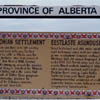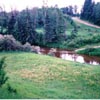Rural communities
 As journalist John Hawkes stated in 1901, "The North-West Territories was a land of many peoples and many tongues." Indeed, ambitious immigrants from all across Europe, including Estonia, arrived here in response to the Government of Canada's advertisements of inexpensive, available land. The land out west was sparsely populated, and the federal government wanted to change this rapidly. The Dominion Lands Act entitled males over the age of 21 to one quarter-section of land for a minimal fee. Government officials advertised homesteads for the modest price of $10 CDN. The ads claimed to be seeking experienced "stalwart peasants born on the soil, whose forefathers had been farmers for generations." The Estonians who immigrated to Canada largely fit this description, having toiled as farmers or labourers under serfdom's oppressive system.
As journalist John Hawkes stated in 1901, "The North-West Territories was a land of many peoples and many tongues." Indeed, ambitious immigrants from all across Europe, including Estonia, arrived here in response to the Government of Canada's advertisements of inexpensive, available land. The land out west was sparsely populated, and the federal government wanted to change this rapidly. The Dominion Lands Act entitled males over the age of 21 to one quarter-section of land for a minimal fee. Government officials advertised homesteads for the modest price of $10 CDN. The ads claimed to be seeking experienced "stalwart peasants born on the soil, whose forefathers had been farmers for generations." The Estonians who immigrated to Canada largely fit this description, having toiled as farmers or labourers under serfdom's oppressive system.
 The railway, along with topographical factors, determined the location of Alberta's communities. Settlers arrived by train at various towns throughout the province including Calgary, Edmonton, Lethbridge, Medicine Hat, and Red Deer. The next task was to find agreeable farming land. Once a location was deemed suitable, it was not uncommon for friends and relatives to gravitate to the same area, thereby creating centralized ethnic ties within the community. The Estonians predominantly settled in three locations: Barons, Medicine Valley, and Stettler-Big Valley. Together, they brought both their farming skills and their support for co-operative ventures. In Alberta's first year as a recognized province, 1905, 80 percent of the population was rural; consequently, it was known to the rest of Canada as the granary of the empire.
The railway, along with topographical factors, determined the location of Alberta's communities. Settlers arrived by train at various towns throughout the province including Calgary, Edmonton, Lethbridge, Medicine Hat, and Red Deer. The next task was to find agreeable farming land. Once a location was deemed suitable, it was not uncommon for friends and relatives to gravitate to the same area, thereby creating centralized ethnic ties within the community. The Estonians predominantly settled in three locations: Barons, Medicine Valley, and Stettler-Big Valley. Together, they brought both their farming skills and their support for co-operative ventures. In Alberta's first year as a recognized province, 1905, 80 percent of the population was rural; consequently, it was known to the rest of Canada as the granary of the empire.
 Alberta's rural towns and villages provided a variety of goods and services for newly arriving pioneer families. Weekly newspapers reporting local, national, and international news were printed. Members of the community would gather to share their opinions on the issues of the day. Moreover, within small towns such as Stettler, professional services, including those of doctors, lawyers, druggists, and blacksmiths, were available. The railway was instrumental in determining the location of a new settlement. Consequently, many early Albertan settlements, including Stettler and Eckville, were situated along the north-south corridor from Edmonton to Calgary. No doubt Alberta's ethnic rural communities were vital to the province's initial development. In fact, by 1911, immigrants from Eastern Europe, including Estonia, comprised 12 percent of Alberta's population. Other smaller Estonian settlements became established in Walsh and Foremost in southern Alberta, Sylvan Lake in central Alberta, and Peace River in the northern part of the province.
Alberta's rural towns and villages provided a variety of goods and services for newly arriving pioneer families. Weekly newspapers reporting local, national, and international news were printed. Members of the community would gather to share their opinions on the issues of the day. Moreover, within small towns such as Stettler, professional services, including those of doctors, lawyers, druggists, and blacksmiths, were available. The railway was instrumental in determining the location of a new settlement. Consequently, many early Albertan settlements, including Stettler and Eckville, were situated along the north-south corridor from Edmonton to Calgary. No doubt Alberta's ethnic rural communities were vital to the province's initial development. In fact, by 1911, immigrants from Eastern Europe, including Estonia, comprised 12 percent of Alberta's population. Other smaller Estonian settlements became established in Walsh and Foremost in southern Alberta, Sylvan Lake in central Alberta, and Peace River in the northern part of the province.








